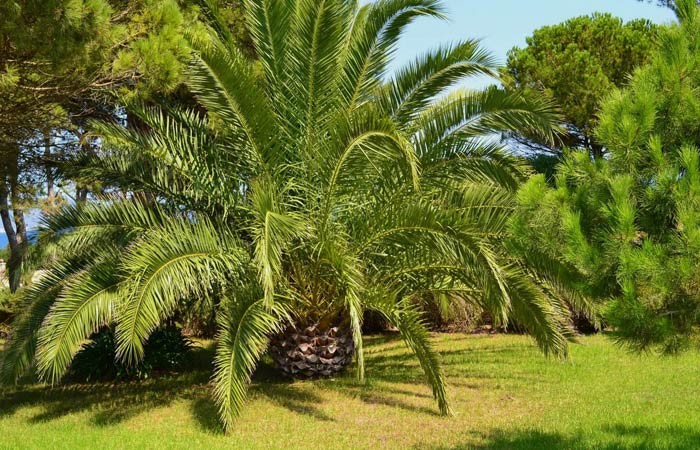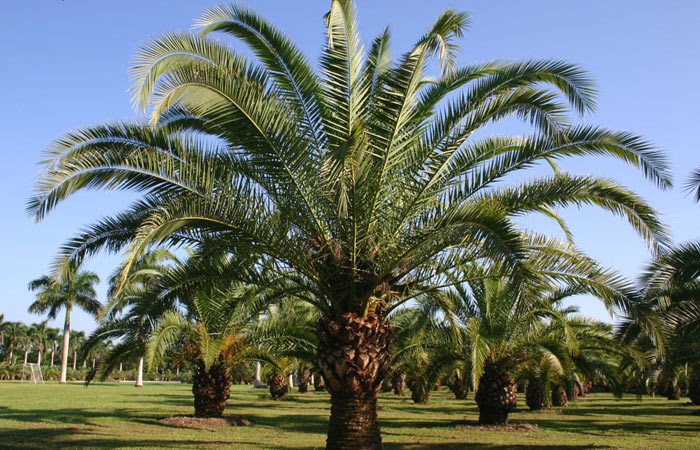Your Complete Pineapple Palm Tree Guide

Pineapple palm (Phoenix canariensis) is one of the most recognizable and stately palm trees in the world. Also known as Canary Island palms or Canary Island date palms, pineapple palm tree is an especially durable palm that thrives from the coastal areas to hot deserts.
The majestic pineapple palm tree can get really big and doesn’t work well in small gardens. But if you have a large enough property to grow a pineapple palm, you will find anything you need to do so in this article.
Pineapple Palm Tree Description
Native to the Canary Islands, where you can find it in scattered populations and different sizes, pineapple palm trees grow in sea-level up to 600 meters in a wide variety of environments, from humid to semi-arid areas. They are hardy and popular palm species with a husk-like stem and wide green leaf bases that are covered with brown, fibrous hair.
Dwarf pineapple palm tree is one of the favorite types of Phoenix canariensis, since they stay short. Dwarf pineapple palm tree has many variations and it is easy to find almost everywhere. A dwarf pineapple palm tree can make a great container plant. They look especially charming in large terra cotta pots. As they look lovely in pots on the patio, in pairs flanking entryways, and near the pool, they are becoming more and more popular among other varieties.
Below, we will take a closer look at these elegant pineapple palm trees:
Pineapple Palm Fruit
Pineapple palm plant has small, off-white flowers as well. These flowers grow on brush-like stalks up to 6 feet (2m) long. Female pineapple palm trees have yellow-orange fruits about 0.8 inch (2cm) with a single large seed that attract the birds. You can eat the fruit pulp, but it is often too thin to be worth eating.
Pineapple Palm Growth Rate
The average pineapple palm tree height is 33 to 66 feet (10 to 20m), but it can grow to 131 feet (40m) as well. Pineapple palm have featherlike leaves that are 13 to 20 feet (4 to 6m) long with about 80 to 100 leaflets on each side of its rachis.
Pineapple Palm Tree Diseases
Pineapple palm plant may be attacked by glasshouse red spider mite, mealy bugs, thrips and scale insects. Attacks from leaf-spotting fungi can also leave brown spots on the leaves. In areas with high levels of humidity, false smut or Graphiola leaf spot is common as well. Bud rot, Ganoderma root, and nutritional problems are among pineapple palm tree diseases too.
Pineapple Palm Tree Root System
Pineapple palm trees roots system is extremely interesting for people, since it has unique features as compared to the other tree species. In a pineapple palm tree root system, the roots don’t grow deeply in the soil. Instead, they spread over the soil and penetrate nearly 36 inches of topsoil. This is called ‘fibrous root system,’ and you can see it if you plant the tree in shallow soil.

Pineapple Palm Care
Pineapple palm tree care can become one of the greatest joys of your life as it is super easy. All you need to provide for pineapple palm tree care (indoors) is good drainage, enough light and enough space. Pineapple palm plant grows slowly and lives for many years.
If you want your palm tree to display its full elegance, buy a pineapple palm plant that is already at least 3 to 4 feet (1 to 1.2m) tall so you don’t have to wait for a long time. Below, you will find important pineapple palm care tips:
Light, Watering and Temperature
Pineapple palm trees grow best in sunlight. But if you are keeping them indoors, provide a filtered light for them. For example, an east or west facing window is an excellent spot for pineapple palm plant. It is recommended to put pineapple palms outdoors in the summer in a place that they can get indirect sun light. For outdoors, pineapple palm tree trivet best in full sun on fertile.
For watering, pineapple palm tree care guides emphasize on avoid over-watering while providing good drainage. Water your young pineapple palm plant sparingly when the potting mixture is slightly dry at the top for healthy look and fast growth. In the winter, reduce watering gradually. Increase watering gradually again when active pineapple palm growth rate begins.
Pineapple palm plant require average room temperatures of 65°F to 75°F (16°C to 24°C). To encourage better growing, provide a winter rest period at about 50°F to 55°F (10°C to 13°C) with no cold drafts. Average room humidity is suitable for this plant. If the air is dry during the summer or from artificial heating, you can improve humidity by misting its leaves.

Soil, Feeding and Fertilizing
Pineapple palms prefer well-drained loamy soils. However, they can tolerate a wide range of soil types, such as sand or heavy clay. They have also the unique feature of tolerating both severe drought and flooding, making pineapple palm plants ideal to grow in housing tracts where the soil was heavily compacted.
Fertilizing can help these hardy trees efficiently. Old pineapple palm leaves often become lifeless due to magnesium or potassium deficiency. You can apply appropriate fertilizer to avoid this. Use a special designed palm fertilizer for right balance of nutrients for your pineapple palm plant. Be careful not to over-fertilize.
Potting and Repotting
Commercially, pineapple palms are grown from palm tree seed which takes about 3 months. But if you are an amateur grower, we recommend planting date stones. If you place them in a warm and moist position, they germinate easily in spring. However, the first leaf is undivided, and it may take up to three years for you to see leaves with pleasing divisions.
Pineapple Palm Tree Trimming
For pineapple palm tree trimming, growers sometimes prune the huge trunk and its sheath in the shape of a pineapple (which is the reason for its common name). Since it is a slow growing tree, it doesn’t require trimming frequently.
In ideal conditions, pineapple palm tree seeds grow pinnate leaves within about a year from germinating and increase to full width in about 5 years, when they also start forming a trunk. From this point, the trunk can grow about 12 inches (30cm) every year, although they are usually slower especially when young.
In general, pineapple palm tree trimming is necessary to remove old fronds that hang below the horizontal. While trimming, don’t remove the growing upright fronds, because this may slow the growth and reduce the tree strength. Also, be careful about spines and sharp edges when handling or trimming.
- In this post:
- Pineapple Palm Tree Description
- Pineapple Palm Care



